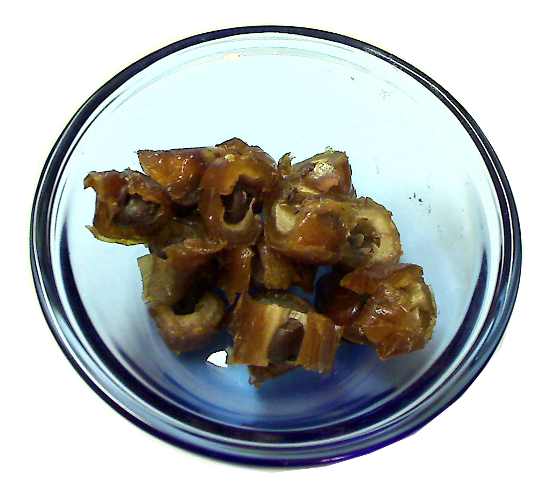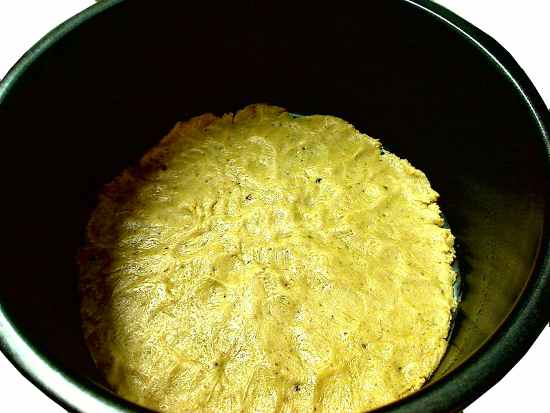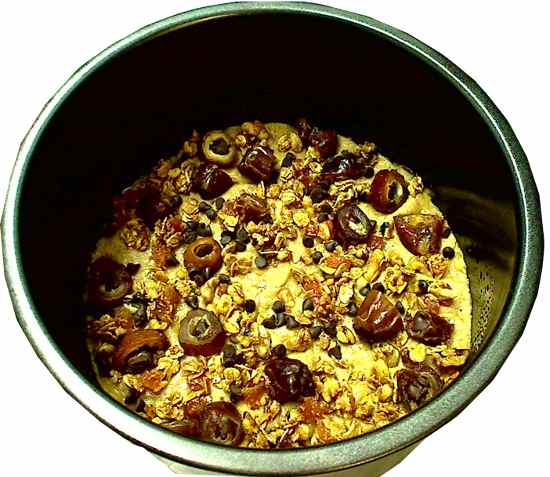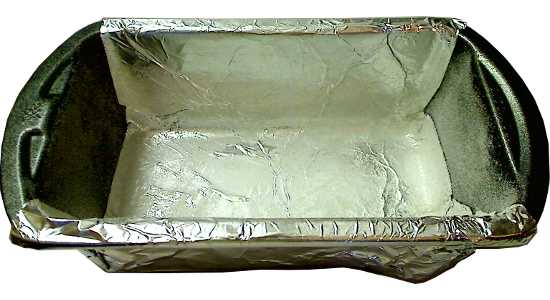
[ Equipment: oven and dehydrator or slow cooker with temperature control. For more information about the terminology in this recipe, see Low Temperature Baking: A Journey of 3 Paths ].
With the year-end holidays approaching, I thought it appropriate to post a recipe for a VaporBaker chocolate chip cookie (not counting the Chocolate Almond Meringue Spiral Cookies, which are really incognito macarons). After several weeks of recipe testing, these cookies didn't turn out as simple as originally intended, but they are made of everyday ingredients - none of them new to the world of chocolate chippers - revived through the techniques of ingredient construction. Each chipper presents jumble of textures and flavors: by turns soft, crisp, moist, sandy, candy crunchy and chewy, perfumed with exotic flavors, faintly fruity, faintly smokey, with bursts of chocolate, the interaction among chocolate dates and apricots, harvest oatmeal, walnuts and intensified black sugar and all capped with a pebbly crust of spicy black-vanilla white sugar.
An explanation of the title: the "wrapped chips" refer to individual chocolate chips stuffed in a date surround. "Trifecta" refers to the trifold composition and purposes of the black sugar. The sugar is forged from 3 ingredients: natural dark brown sugar, molasses and dates, and deployed in 3 ways: as a primary sweetener, a binder for the granola and as a flavorful topping.
These are twice-baked cookies, once in a slow oven and once in a dehydration oven, like a biscotti but more delicate, a wonderful eating experience. My only regret is that they are so labor intensive I cannot make them too often. The prep time for the dough alone from scratch demands 2 days (a lot of it is waiting time). Plus, oven time (first and second bakings) can stretch up to a full day more.
Speaking of black sugar, the actual flavor inspiration for this recipe came from a vintage recipe for chocolate caramels, first published in 1881. It was reprinted in the New York Times Recipe Redux column in February 2010. The 6 ingredients (butter, chopped chocolate, milk, sugar, vanilla and molasses) are same for basic chocolate chip cookies, minus the flour and egg. The chefs in that column re-imagined the ingredients into a dessert called Black-Sugar-Glazed Medjool Dates With Pecorino and Walnuts. It was the discussion of these recipes that got me to thinking about ways to incorporate black sugar into a chocolate chip cookie.
I approached this recipe as an opportunity to make a different chocolate chip cookie with ordinary cookie ingredients, but constructed into various forms for the different flavors and textures. The concept is: the whole is different from the sum of its parts. For example, the dehydrated molasses sugar (an intermediate step in the making of black sugar) tastes something like Chinese block sugar (an unrefined sugar), not the same as before dehydration. Another constructed ingredient is the black-sugar granola, which is dried until rock-hard to resist blending into the dough. I wanted granola chunks in the cookie, not oatmeal-chocolate chip cookies. The wrapped chips explode a chocolate and date medley when chewed, distinct from the free-floating chips in the cookie. Constructive activity tallies the prep time, but changes ordinary ingredients into new foods.
The Constructed Ingredients and Substitutions
The powdered black sugar, black sugar granola and date sugar are all fabricated with the help of a food dehydrator or dehydration oven set at around 130°F. The temperature is higher than my usual limit of 120°F. However, the cookies slow-bake anyway at 250°F, and the higher drying temperature balances preservation of flavors with expeditiousness.
The base ingredients for the black sugar (dark brown sugar, molasses and date sugar) should be of high quality. Pure cane dark brown sugar is said to be brown all the way through (as opposed to being white sugar lightly coated in molasses). I bought an unsulphured "first" molasses (Grandma's brand) for my food bin, but stronger unsulphured grades would be fine too. I made date sugar by dehydrating and grounding dried Deglet Noor dates (also sold in markets near me as "California dates"). Medjools taste sweeter, but their higher water content would mean more time in the dehydrator. In general, dried dates for eating would turn to paste in a grinder, and must be dehydrated before grinding into date sugar.
Although sugar of one form or another pops up everywhere in the cookies (the "trifecta" of black sugar), they're only mildly sweet, which is my taste preference. In earlier batches, I did feel a need for more punch in the sweetness. Towards that goal, I mix a small amount of white vanilla sugar into the topping (1 to 1 ratio with the black sugar) and sprinkle over the cookies before baking. The topping method adds the white sugar punch with fewer calories.
The granola should be dry and very pebbly, about 1/4 to 3/8-inch chunks, so that they hold onto their individual character when mixed into the cookie dough. To construct the granola with a robust binder that doesn't crumble when mixed into dough, I add almond meal, which combines with the molasses to form a paste that dries into a granola mortar. The recipe makes about 3/4 cup. 1/2 cup goes into the dough. I munch on the remaining 1/4 cup while making the cookies.
I make the wrapped chips by stuffing dates with chocolate chips and slicing them into individually wrapped chips. Again, I prefer the Deglet Noor dates, being smaller and drier, to the Medjools for this purpose. Dates that were pitted without splitting hold the chips more securely. Although Medjool-wrapped chips would be very tasty too, and sweeter, the chips don't fit snuggly into those larger fruits.
The long and involved preparation of the constructed ingredients for these cookies can be a trial of patience (it has been for me), but there are good shortcuts. A mixture of commercial dark sugars, such as a granulated dark muscovado and prepared date sugars, ground to powder, would be a fine substitute for the composite black sugar. However, few American markets stock them. Where they are available, they are usually too wet and must be dried out for a few hours. The homemade black sugar has a higher concentration of molasses than dark muscovado (25% vs. 13% if my math is correct), so the substitutions may not taste as intense.
There are a very few commercial molasses granolas, but none that I could find with only apricots. A fruitless molasses granola or granola cereal, enhanced with chopped apricots, would be a good substitute for the homemade black-sugar granola. Packaged date sugar is more widely available. If the date sugar is coarsely ground, it should be re-ground to a fine powder.
I introduced the homemade baker's 5-spice blend in my 5-spice oatmeal cran-raisin cookies. Substitute with Penzey's baking spice. Some of these conveniences are a tiny bit pricey. Date sugar sells around $5 US per pound. Dark muscovado sugar can run from $5 to $10 US per pound.
Other Ingredients and Baking Tips
The apple fiber aids with moisture retention in the cookie and adds fruity tones and even dietary fiber, but does not significantly hydrate the dough as applesauce would. Although the cookies are twice-baked, the apple fiber holds onto a wisps of moisture over the course of the second baking, for a barely-there inner softness. With extreme drying from the second baking, however, the cookies assume a candy-like crunch, to which the apple fiber definitely contributes. The apple fiber is separated from applesauce by draining the juice. Dehydrating the applesauce would leave the fiber with overly-assertive apple flavor.
Coffee bean powder is canned ground coffee (I used a Folger's medium roast) that's been further ground in a coffee grinder into a VERY fine powder. It must be VERY fine, or the cookies will taste gritty. In this recipe, the coffee bean powder enhances the flavor of the chocolate chips and the black sugar. Espresso powder (which is brewed, dried and then bottled coffee grinds) will also work.
Be careful not to overbake the cookies (they overbake very easily), because the heat can harm the delicate flavors, not to mention the overpowering taste of burnt dough. In the first baking, the cookies are ready when the edges touching the sides of the pan are LIGHTLY brown. They emerge from the first baking a little cakey and moist. They can be served after the first baking, but (in my opinion) attain apotheosis after the second baking, when the crisper delicate texture unveils the subtler flavors.
The second baking takes place under dehydration temperatures because the cookies will burn if they continue to bake in a slow oven and because dehydration preserves flavors. I specify a dehydration temperature range of 120 to 140°F (49 to 60°C). Although most of the enzymes in the ingredients have been deactivated during the slow-baking, flavors are still temperature sensitive. Just-moist cookies (hard on the outside, softer on the inside) are delicious, but I adore them very brittle-crisp or "bone dry" (dried for about 20 hours at 140°F/60°C). Anticipate this second baking to last anywhere from several hours to almost a full day.
The 16 cookie yield may seem to be a stretch, but somehow it feels right. Each 1/16th of the pan biscuit tastes like a full cookie in its own right: packed with flavor and is a satisfying taste experience. I feel this to be true each time I eat one.
Makes 16 cookies
- 90 calories per cookie
- Oven Temperature: 250°F/121°C
Cookies:
- 1/4 cup powdered black sugar (see below)
- 3 tablespoons butter
- 2 teaspoons apple fiber (see text)
- 1/4 teaspoon vanilla extract
- 1/2 beaten egg (2 tablespoons)
- 3/4 cup all-purpose flour
- 1/4 teaspoon baking powder (see text)
- 1/4 teaspoon baking soda
- pinch of salt
- 1/8 teaspoon coffee bean powder (see text)
- 1/2 teaspoon baker's 5-spice (see text)
- 1/4 teaspoon dried lemon zest
- 1 tablespoon mini chocolate chips
- 1/2 cup black sugar granola (see below)
- 1/2 teaspoon vanilla sugar
- 1/2 teaspoon black sugar (see below)
- 1/4 teaspoon baker's 5-spice
- 1/4 cup dark brown sugar, packed
- 1 tablespoon unsulfured molasses
- 4 dried dates, chopped (see below)
- 1/8 cup unsweetened applesauce
- 7 dried dates (Deglet Noor, about 1-1/2 inches in size - see text)
- 21 regular-size chocolate chips
- 1/4 cup rolled oats
- 1/4 cup chopped walnuts
- 2 teaspoons finely ground almonds or almond meal
- pinch of salt
- 2 tablespoons chopped, dried apricot (about 3 dried apricots)
- 3-1/2 teaspoons unsulphured molasses
- 1/8 teaspoon baker's 5-spice

1. Put brown sugar and molasses in a small bowl and toss-mix with a fork, breaking up any lumps. The texture of the sugar should be very granular.

2. Dehydrate the sugar for 12 hours at 130°F/54°C until completely dry. In a commercial dehydrator, follow the manufacturer's instructions. In a converted slow-cooker with temperature control, pour the granola into a wide, greased bowl and spread it out. Place the bowl in the cooker on a trivet.

3. To speed up the drying, every 3 hours, remove from dehydrator and gently pound the sugar flat with pestle to crush the sugar crystals. Then fluff it with a fork. Replace in dehydrator and continue drying. The sugar is ready when the surface has lightened and hardened. If the air is very humid, it may take more time in the dehydrator to reach this stage.

4. Unless the chopped dates are rock hard, they contain excess water and will grind to a paste. Dehydrate them for 24 hours at 130°F/54°C until completely dry. With a commercial dehydrator, follow the manufacturer's instructions. In a converted slow-cooker with temperature control, put the chopped dates in a small pan or dish and place on a trivet in the cooker. The dates and molasses sugar can be dehydrated together at the same time, in the same cooker.

4. Break up the hardened molasses sugar into small chunks. Put the molasses sugar in a coffee or spice grinder with the dried dates. Grind until the mixture is a fine powder.

5. Store in an airtight container until ready for use.
Black Sugar Apricot Granola Method:

1. Mix oats, walnuts, apricots and almond meal in a small bowl.

2. Mix in molasses until the dry ingredients are evenly coated.

5. Pour into a greased dish. Dehydrate the granola for about 8 hours at 130°F/54°C or until granola is completely dried and hard. For a commercial dehydrator, follow the manufacturer's instructions. For a converted slow-cooker with temperature control, transfer the granola to a wide dish and spread it out to dry faster. Put a trivet in the cooker and sit the dish on it.

6. GENTLY break granola into large chunks. Store granola in an airtight container until ready to use.
Wrapped Chips Method:

1. Stuff each date with chocolate chips. I can usually fit 3 chips per date. In the picture above, the dates were sold already slit along the side. Try and get dates that are not slit, because they will hold the chips more securely.

2. Slice the dates into individual date-wrapped chips.

Apple Fiber Method:

1. Line a small sieve with two layers of paper towels. Spread the applesauce over the towels and allow to drain for about 1 hour.
2. Fold up the towels around the applesauce and GENTLY squeeze out any excess juice in the applesauce.

3. Open the towels and scape out the apple fiber with a spoon. With my brand of applesauce, 1/8 cup of applesauce reduced to about 2 teaspoons of apple fiber.
Cookie Method:

1. In a small bowl, thoroughly whisk flour, baking powder, baking soda, baker's 5-spice, coffee bean powder, lemon zest and salt. Set aside.

2. In a large bowl, cream softened butter and granulated black sugar with a fork until well combined.

3. Add 2 tablespoons of beaten egg, vanilla extract and apple fiber and beat until light and fluffy.

4. Add flour in portions, mixing with the whisk and then a wood spoon and then kneading (if necessary) in the final portions of flour to form a SOFT, non-sticky dough. If needed, add 1 or 2 teaspoons more flour to achieve a good consistency.

5. Grease a 7-inch springform pan or cake pan with removable bottom. Cut out a 7-inch diameter circle from wax paper or parchment paper and place in bottom of pan. Grease the top of the paper.

6. Divide the dough in half. Break off pieces from one portion of the dough, and pat them evenly onto bottom of pan.

7. Break granola into chunks to about 1/4-inch or a little larger and sprinkle evenly over the dough - but leave an area at the center clear (a circle of about 1-inch diameter) for easier cutting later. Then sprinkle the wrapped chocolate chips and 2 teaspoons of the mini chocolate chips evenly over the dough - again leave the area at the center clear. Gently press the granola and chips into the dough. Be careful not to crush the granola or unwrap the chocolate chips, so that they retain their individual characteristics within the cookie.

8. Break off pieces from the remaining portion of dough, and distribute them evenly in the pan.

9. Press the dough pieces flat to completely cover the granola and chips. Allow some of the granola and chips to peek through the dough top layer.

10. Sprinkle the remaining 1 teaspoon of mini chocolate chips over the dough and press them slightly into the dough to secure them. Then mix the topping ingredients in a small dish and sprinkle evenly over the top of the dough.


11. Score the dough with a knife or flat-bladed dough scraper into 16 wedges. The scoring should go through the thickness of the dough. Cut templates from wax paper to aid accurate scoring.

12. Bake for 40 to 45 minutes or just until the edges touching the pan are a VERY light golden brown. Do NOT overbake or the cookies will have a burnt taste. Cool for 10 minutes in pan. Unmold and continue cooling on a rack. With a knife, press down into score marks on the cookies to separate them.

10. For the second baking, put the cookies in a food dehydrator or dehydration oven set in the range of 120 to 140°F (49 to 60°C) and dry them for several hours or overnight until they are crisp and crumbly or to desired degree of crispness.






































